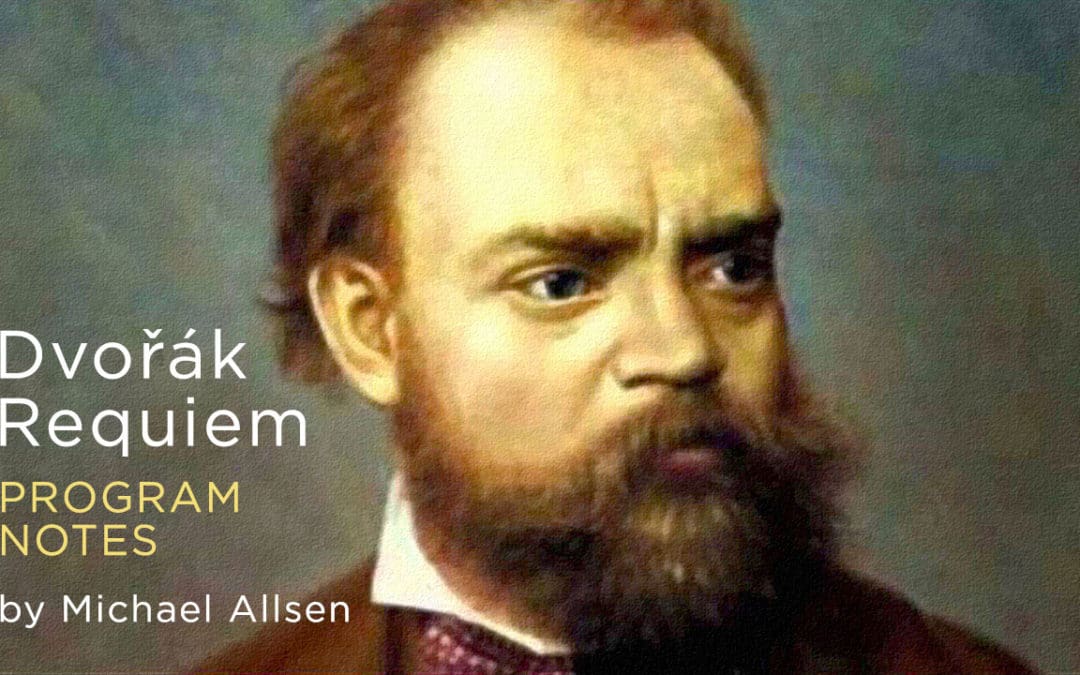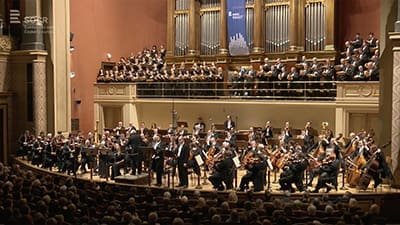We planned to devote our April 1, 2, and 3, 2020 program to a monumental choral work—what would have been our first performance of Dvořák’s great Requiem. His version of the Latin Mass for the Dead is one of the largest of all settings of these traditional texts, and his vision is uniquely lyrical—unified musically by the mystical passage heard at the beginning. Four distinguished vocal soloists were to join the orchestra and the Madison Symphony Chorus to present this powerful work: soprano Ann Toomey, mezzo-soprano Julie Miller, tenor Eric Barry, and bass-baritone Matt Boehler.
Although we were not able to present this concert as planned due to the coronavirus pandemic, we invite you to read through Michael Allsen’s program notes and watch a previously recorded performance of the piece by the Prague Radio Symphony Orchestra.
To experience the Dvořák Requeim virtually, watch this 2016 performance by “SOČR, Symfonický orchestr Českého rozhlasu.
Progam Notes
Antonín Dvořák (1841-1904)
Requiem, Op.89
Dvořák composed this work between December 31, 1889 and October 31, 1890. He conducted the premiere in Birmingham on October 7, 1891. This is the first performance the work at these concerts. Duration: 90:00.
By the later 1880s Dvořák was widely recognized as one of Europe’s greatest composers. He was of course the leading musician in his native Bohemia, but his music was perhaps even more popular in England. In early 1884, he visited England for the first time at the invitation of the Birmingham Choral Festival, where he conducted the first British performance of his Stabat Mater. Later that year, he conducted the same work at the Worcester Festival. Dvořák would eventually visit England eight times, and his English connections would become a valuable source of commissions. His Symphony No.7 of 1885 (played at our opening concert this season) was the first of several large works written for English orchestras or festivals. His large choral works, previously little known outside of Bohemia, proved to be particularly popular in England, where they were frequently programmed at the great British choral festivals. The history of his Requiem began in 1885, when he returned to the Birmingham Festival to conduct the premiere of his cantata The Spectre’s Bride. The managers of the festival responded almost immediately with a second commission for a large choral work that they hoped will be ready in time for the 1888 festival. Several other projects intervened, including a previous commission for the oratorio St. Ludmila (1886) written for the Leeds Choral Festival, his opera The Jacobin (1887-88), and the Symphony No.8 (1889). Dvořák also seems to have taken his time searching for a proper libretto for the Birmingham piece—he considered, but abandoned The Dream of Gerontius—which would be set in a tremendously successful oratorio by a young Edward Elgar several years later. In May 1889, his London publisher Alfred Littleton wrote to him suggesting that he might try a Requiem.
The Latin Requiem is a daunting choice for any composer, both in the challenge of the texts themselves, and in the idea of stepping into a venerable tradition. The first polyphonic settings of the text were composed in the 15th century, and there is an unbroken tradition of Requiem settings that continues down to our own day: there are hundreds of settings of the complete Mass for the Dead, or its individual movements. In the 19th century, there were of course the titanic versions by Berlioz and Verdi, but one Requiem that may have been more influential on Dvořák was the 1816 Requiem in C minor by Luigi Cherubini. Though it is seldom heard today, this setting was one of the most popular choral works of the 19th century, and Dvořák seems to taken it as a model in laying out his own setting of the Requiem. For Dvořák, who was a devout Catholic and deeply respectful of the texts and associated ritual, the more reserved and classical approach of Cherubini, was more attractive than the theatrical—and even bombastic—settings of Berlioz and Verdi. However, given that this was to be a concert work, he felt free to slightly rearrange and occasionally combine the traditional Requiem texts in a way that suited his personal vision
Dvořák would devote the first ten months of 1890 to the work—by mid-January, he wrote to a friend that “I thought you might be interested to learn that I am currently working on a great Requiem which is to be performed in Birmingham in 1891. The first part, then the Dies irae and the Tuba mirum as far as Quid sum miser are already completed. If God permits and things carry on in this way, it should really be something.” It turned out to be “really something” indeed. Dvořák completed the work in July, and finished the orchestration in late October. The premiere a year later in Birmingham was a stunning success, and additional performances in England and Bohemia quickly followed. A review of the Prague premiere in 1892 is typical of the response:
“The Requiem exceeded even our most audacious expectations. We can only use superlatives to describe a product of this caliber. He [Dvořák] who witnessed the atmosphere this work generated even during the orchestral rehearsals at the theatre, he who sensed the fervor among the performers themselves during the awe-inspiring, breathtaking Dies irae, could not resist the magic through which this prayer incarnate, this epic of somber mysticism, besieges the soul. Only he whom music has permitted to glimpse the innermost maze of the human heart, he who, instinctively or unconsciously, is guided by his inspiration to create something beautiful and precious; only he can speak the language of music with such conviction.”
The opening movement, which combines the processional Introit chant Requiem aeternam and the Kyrie, begins with an unsettling motive, chromatic and winding, played quietly by the strings. Dvořák used this idea throughout the work as a unifying idea. The chorus delivers the opening lines in a mood of hushed reverence, until a great outburst on Te decet hymnus, Deus, in Sion (“A hymn in Zion befits you, O God”). This text, sung in a solemn chant style, is picked up and decorated by the soloists. The closing Kyrie is sung first almost sotto voce, then in a more glorious style. The second movement sets the Gradual chant Requiem aeternam, which amplifies the text of the Introit, in a fervent solo for the soprano. The chorus interjects at a few points, and provides a hushed, prayerful setting of the final line.
At the center of the Latin Requiem is the Sequence chant Dies irae (“Day of wrath”), which was written by the 13th-century monastic poet Thomas of Celano. This text dwells on the terror of the Day of Judgment foretold in the Book of Revelations, and interjects prayers for safety from the Lord’s wrath. Dvořák divided this lengthy text into five movements, opening with the stormy Dies irae itself. This begins with a foreboding trombone note, and the chorus solemnly intones the Latin imagery of death and destruction. A solo trumpet, playing the unifying motive heralds the Tuba mirum in a dour opening passage, which gives way to a threatening string accompaniment to the mezzo-soprano and baritone. The tenor’s solo, beginning at Liber scriptus (“A written book”) changes character, as the orchestra makes short responses to his lines. The movement ends with a reprise of the terrifying Dies irae and a triumphant setting of Tuba mirum. The supplicating text of Quid sum miser begins with quiet choral music that subtly incorporates the opening motive. All four soloists join in laying out this text, which reaches its climax with a fierce fugal setting of the words Rex tremendae majestatis (“King of dreadful majesty”). The next section of text, Recordare, is a series of prayers to Jesus himself, and Dvořák responded with much more intimate music featuring the four soloists. His setting carefully responds to the meaning of the text, referring to the motive at a few points, but the overall mood of the movement is hopeful, concluding in a beautiful pastoral passage. The chorus responds with the strident Confutatis, where the sweeping string figures clearly portray the flames of Hell. This music alternates with more personal prayers for redemption, leading to an optimistic conclusion. The sequence’s final section, Lacrimosa, begins with a series of forlorn lines from the soloists, with the idea of judgment highlighted in grand outbursts by the brass and chorus. The mood changes, however, in the final, pleading, lines of text, before the movement ends with a solemn Amen, and one last reference to the Requiem’s primary motive.
In Part II, the texts become more comforting in nature. Dvořák divided the Offertory into two sections, beginning with Domine Jesu Christe. This movement starts with glowing music from the woodwinds before a brass fanfare ushers the men’s voices for a chantlike statement of the opening text. Most of the text is carried by the soloists in unhurried lyrical lines with answers from the chorus. At the mention of St. Michael the Archangel, the music becomes more strident, leading to a grand concluding fugue on quam olim Abrahae promisisti (“which you once promised to Abraham”). The Hostias begins with a dark fanfare that introduces the soloists, who carry the text with remarkable choral interjections by the men. The movement ends with a reprise of the quam olim Abrahae fugue.
The Sanctus begins with gentle, lilting solo lines, until the trombones begin a more forceful version of the opening invocation (“Holy, holy, holy”). Much of the movement, however, is quiet and introspective, with the Requiem motive subtly worked in—though each half ends with the exalted Hosanna music. The short prayer Pie Jesu is drawn from the end of the Dies irae sequence and is not a part of the standard Requiem text. Here, however, Dvořák seems to have followed Cherubini in including it as a separate movement, where it serves as a quiet, heartfelt interlude between the weighty Sanctus and the extended Agnus Dei. The concluding movement opens with a reference to the Requiem motive, and a short invocation by the tenor, before a quiet choral statement of the words Agnus Dei (“Lamb of God”)—one of the few distinctly Slavic-sounding moments in the Requiem—and a phrase that is used to tie this last movement together between the solo passages. In a lengthy concluding section, Dvořák grafts most of the Requiem’s closing Communion chant, Lux aeterna, on to the end of the Agnus Dei. This celebration of “eternal light” quickly rises to lofty levels, before subsiding into a long and reserved conclusion, dominated by transformations of the Requiem motive.
Click here to read the texts and translations for this piece
________
program notes ©2019 by J. Michael Allsen


